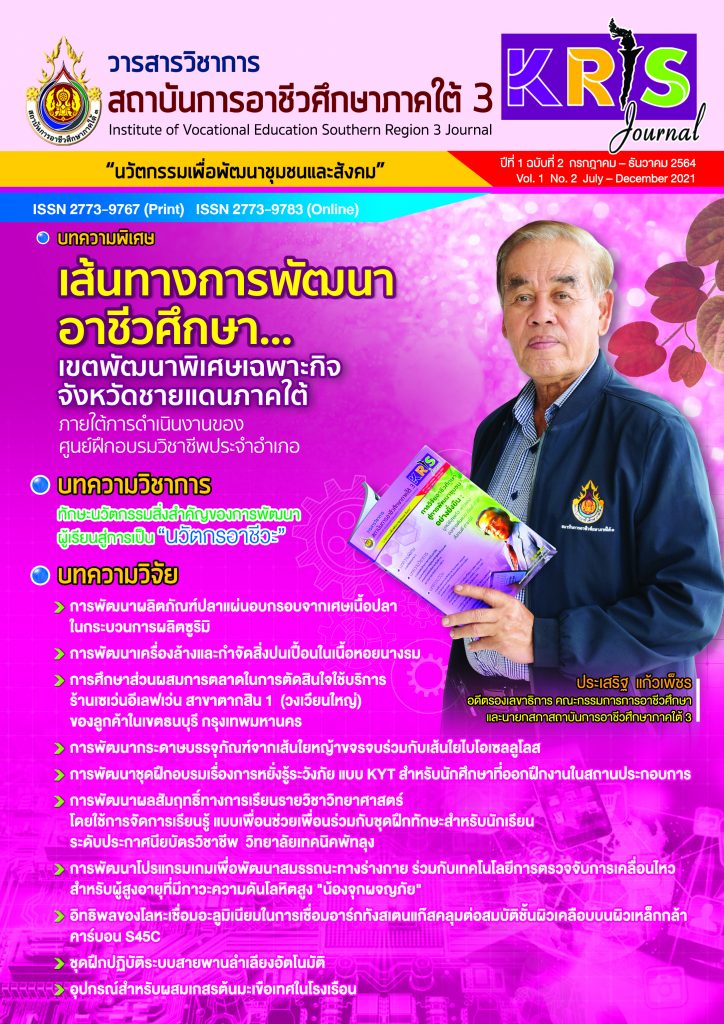Development of Packaging Paper from Cellulose of Desho Grass and Bio-cellulose
Keywords:
Paper, Packaging, desho grass (Pennisetum Pedicellatum), Bio-celluloseAbstract
This paper presents a guideline for preparing a paper with the aims at: 1) determining the optimal ratio of the desho grass fiber and 5 ratios of bio-cellulose fibers affecting the structural and mechanical properties of the packaging paper, 2) comparing the water permeability between the paper from the desho grass fiber and the bio-cellulose fiber with commercial craft paper in the market, and 3) studying the experts' opinions on the 4 types of products from desho grass and bio-cellulose fibers, i.e. envelop, bag, cup, and plate. The sample group included 7 experts in packaging design and development. The research instrument was a packaging suitability assessment form to evaluate the paper packaging. The statistics in the data analysis included F-test, CV (%), X, and SD. The results showed that: 1) the ratio between the amount of desho grass fiber and bio-cellulose fiber at 0.25:0.75 had the greatest structural properties of 36.6500 kg/m3. The ratio of 1: 0 had tensile strength and the folding endurance of 10 newton with 658.33 folding times. 2) The percentage of water permeability of packaging paper from the highest to the lowest were as follows; desho grass fiber and bio-cellulose based paper (74.84%), desho grass fiber and bio-cellulose with chitosan solution (53.74%) and craft paper (42.15%) respectively. 3) The forms of packaging with the most appropriate design starting from bag (4.53 ±0.66), envelope (4.17 ±0.21), cup (3.96 ±0.75), and plate (3.62 ±0.38) respectively. This study provides a guideline which can be applied to develop paper packaging with environmental friendly and biodegradable.
References
บุปผาชาติ ยศคันโท และคณะ. (2555), การศึกษาคุณสมบัติของเซลลูโลสแบคทีเรียเพื่อการผลิตกระถาง ย่อยสลายได้ การประชุมวิชาการเครือข่ายวิศวกรรมอุตสาหการ ประจำปี พ.ศ. 2555. (น. 1281 - 1287) เพชรบุรี : มหาวิทยาลัยศรีปทุม.
มลสุดา ลิวไธสง. (2556). การผลิตภาชนะย่อยสลายได้ทางชีวภาพจากกาบกล้วย (ปริญญานิพนธ์) สาขาวิชาวิศวกรรมเครื่องกล มหาวิทยาลัยเทคโนโลยีสุรนารี.
ลดามาศ เบ็ญชา และคณะ. (2559) ม.ป.ป. ความเป็นไปได้เบื้องต้นในการผลิตบรรจุภัณฑ์ที่เป็นมิตรต่อ สิ่งแวดล้อมจากเศษวัสดุเหลือ ทิ้งทางการเกษตรในพื้นที่จังหวัดเชียงราย, นเรศวรวิจัย, ครั้งที่ 12 : วิจัยและนวัตกรรมกับการพัฒนาประเทศ. (น.418 - 423), มหาวิทยาลัยนเรศวร: กองบริหารการวิจัย.
รัชพล พะวงศ์รัตน์. (2558), กระบวนการปรับสภาพเพื่อเพิ่มประสิทธิภาพการผลิตเอทานอลจาก วัสดุเหลือทิ้ง ทางการเกษตรประเภทลิกโนเซลลูโลส, วารสารวิชาการ Veridian E-Journal, สาขาวิทยาศาสตร์และเทคโนโลยี, มหาวิทยาลัยศิลปากร,2 (1), 143 - 157.
นิษฐกานต์ ประดิษฐศรีกล. (2558). คุณภาพของแผ่นวุ้นเซลลูโลสจากการเพาะเลี้ยงด้วยสารอาหารเสริม ที่แตกต่างกันในน้ำสกัดเศษข้าวโพด. (รายงานวิจัย) สาขาวิชาวิทยาศาสตร์และเทคโนโลยีการอาหาร คณะเทคโนโลยีการเกษตรและอุตสาหกรรมเกษตร มหาวิทยาลัยเทคโนโลยีราชมงคลสุวรรณภูมิ.
ล้วน สายยศ และอังคณา สายยศ. (2539). เทคนิคการวัดผลการเรียนรู้ กรุงเทพฯ : สุวิริยสาส์น.
สุธิดา คงทอง. (2552). ไคติน-ไคโตซาน (Chitin-Chitosan), วารสารอุตสาหกรรมศึกษา, 3(1), 1-7.
Downloads
Published
How to Cite
Issue
Section
License
Copyright (c) 2024 Institute of Vocational Education Southern Region 3 Journal (KRIS Journal)

This work is licensed under a Creative Commons Attribution-NonCommercial-NoDerivatives 4.0 International License.






